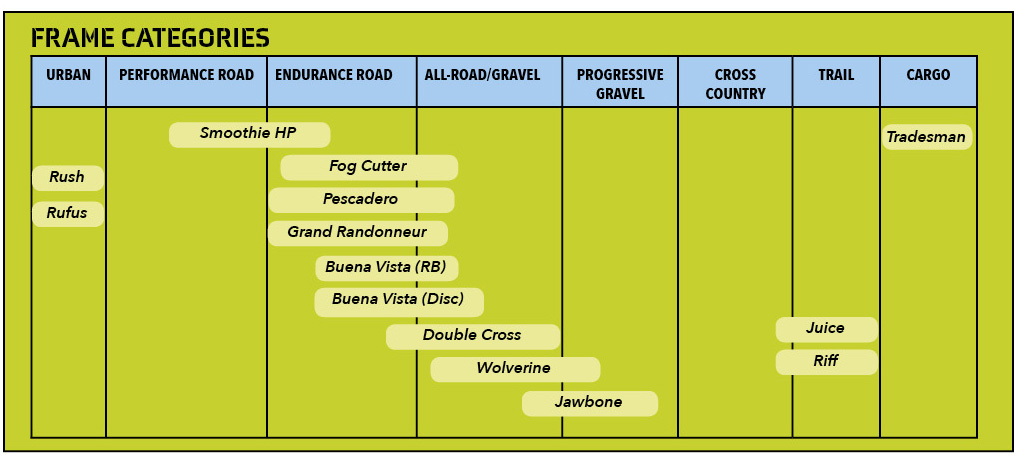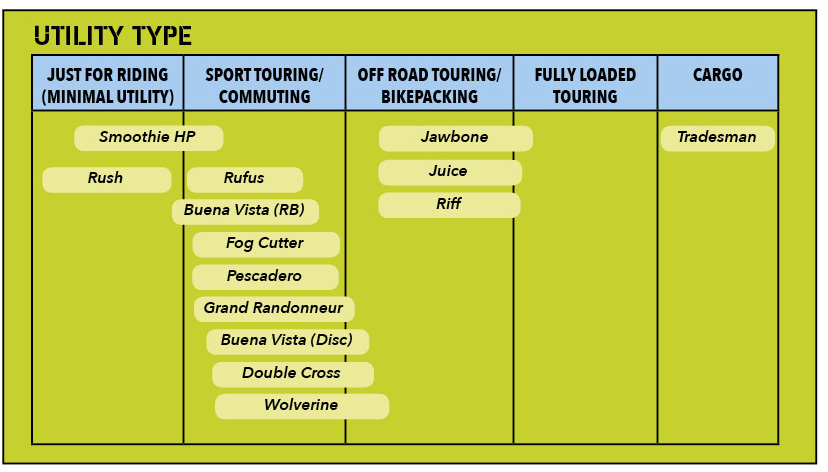How to Choose the Right
Soma Frame for You

"Frame Categories" are helpful in starting conversations on what bike you might need.
But current mainstream categories are a not perfect, especially since most of our frames do not fit nicely into just one category. Our frames have always been designed to be multi-use. Our Smoothie HP is straddles the Performance and Endurance because it has a nimble geometry but a tallish stack. The Smoothie HP and Rush are also categorized in the “minimal utility”, but the Smoothie has rear rack mounts and the Rush makes a decent messenger bike; still the usual customer for these models is going to use it more for recreation and "getting around" than getting groceries or touring.
We always ask the customer what type of riding you usually do and what type of riding you aspire to do.
Example: You usually just commute 10 miles one way on your commute, but you aspire to 50 mile weekend rides with the local shop and maybe do an occasional gravel ride. And we want you to think about how much you value speed and lightweight vs. durability and versatility. Think about comfort, too. Our thinly butted steel tubing usually gives a less jarring ride than some other materials, but comfort can also be had if a bike can fit wider, plusher tires, and also setting up a less aero, less fatiguing ride position.
Here is our definitions of the mainstream categories so we are all on the same page
Racing:
These frames prioritize lightweightness, stiffness and agressive geometry, so you can steer precisely as well as ride in an aerodynamic position. Usually limited to 700c x 23 to 28mm tires. You won't find a racing model in our line-up. They are expensive and generally built too light to take the wear and tear of every day riding. There are plenty of brands offering excellent race bike options. We haven't felt the need to join in.
Performance Road:
Nimble handling, aerodynamics and acceleration, as needed in racing or more competitive club rides, is prioritized over a more comfortable riding position.
Endurance Road:
Fast and efficient riding over paved roads, but with a slightly more upright riding position. A longer wheelbase trades nimble steering for more stable handling desired for long days in the saddle. More tire clearance allows for more wider tires that cushion the roads better. They are optimized for, but don't have to built with typical road bike drop bar. Most of our Buena Vista mixte frames are built into city bikes.
All-Road/Gravel:
More tire clearance (max. about 38-45mm) to allow better off-road performance and more comfortable rough pavement performance. Less nimble steering than performance road and endurance road bikes, but the extra stability gives you more confidence on gravel road and dirt paths. They are optimized for, but don't have to built with typical road bike drop bar.
Progressive Gravel:
Slacker, more mountain bike-like geometry than regular gravel bikes for more confident on-dirt handling. Able to fit mountain bike tires 2.0” and larger.
Cross Country:
Mountain bikes designed for speed, climbing efficiency and sharper handling on single track and semi-technical terrain. Usually designed for XC racing, so they have a lighter frame than other categories of mountain bikes. Our hardtail frames feel great on "cross country" terrain, but they are built for durability, instead of being race light.
Trail:
The most well-rounded of mountain bike styles, falling between Cross-country and All-mountain/enduro bikes in terms of their balance of weight vs. strength and uphill vs. downhill capabilities. Not race light, but not heavy and chunky either.
Urban:
Designed for city use and general getting around. Best for short and medium distances usually.

We love it that there has been a growing interest in bike packing, touring, and commuting over the years. Bikes are transport, not just expensive toys. Here is a Utility Chart to supplement the Category Chart. All but one of our frames have rear rack options. Some have forks that can mount front pannier racks and/or mini racks. Maximum load with rider, racks, and cargo of our non-Cargo frames is 270 lbs. So take things with you. Pick stuff up. Bikes can be super-practical as well as super-enjoyable.
Just for riding (minimal utility):
Built for speed and fun and not designed for carrying significant cargo on the frame in an efficient manner. All of our frames not in the "just for riding" category can be used for general fun too, except for maybe the Tradesman.
Sport Touring:
Can carry light to medium loads (10 to 30 lbs) without the cargo affecting steering: A front basket or front bar bag. Or using a front and/or rear rack with panniers or trunk bags. Transfer some weight from panniers to a frame bag and you might be able increase the load capacity a little. Rides enjoyably and comfortably without a load on paved road and smooth dirt, too. Sporty without being racy.
Fully Loaded Touring:
Designed to carry med-to-large front and rear rack and panniers efficiently over long distances on mainly paved roads and smooth dirt. The heavier frame is designed to resist being flexed by bigger front and rear loads (25 lbs and up) and has a long wheelbase that offers predictable steering when loaded down. Usually designed to use a kickstand to keep the bike upright when stopped.
We don't classify any of our frames as "fully loaded touring", because they don't have the extra low bottom bracket height and aren't designed with kickstand plates.
Our Jawbone would be the closest because it has slightly burlier tubing than our other 700c wheel frames and a longish wheelbase, but it doesn't have a extra low BB height or a kickstand plate.
Off Road Touring/Bikepacking:
Designed to carry frame bags, cargo cages or racks. Fits at least 2.0” wide knobby tires and frame geometry suited for predictable handling on rough dirt roads. These frame usually don't run kickstands, because kickstand don't work well on uneven terrain or soft dirt terrain.
Cargo:
Designed specifically to carry cargo (groceries, kids, pets, garage sale scores) on mainly paved roads. They usually have integrated racks that are more heavy duty than those found aftermarket. While many of our frame can carry cargo, a true cargo bike should allow a rider of average skills to transport at least 40 lbs of cargo with no difficulty.